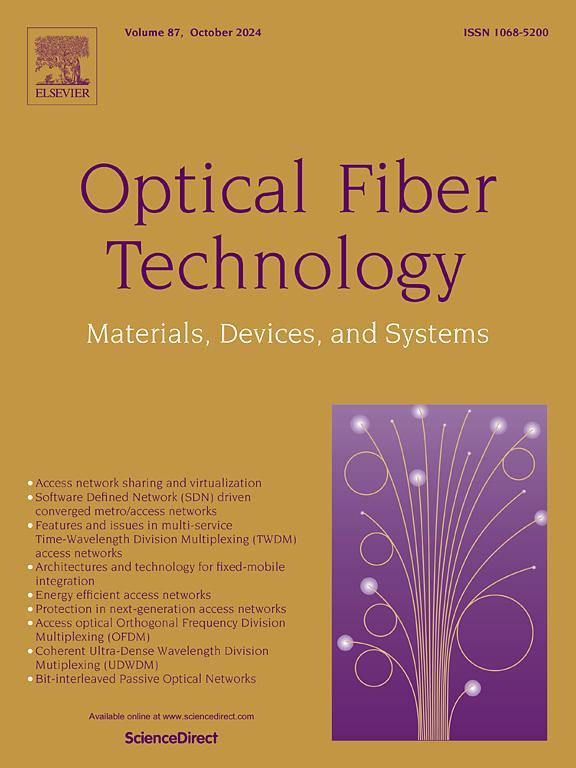Comparative analysis of Signal-to-Noise ratio in Raman microscopy using conventional cuvette based measurements and Hollow-Core microstructured polymer optical fibers
IF 2.7
3区 计算机科学
Q2 ENGINEERING, ELECTRICAL & ELECTRONIC
引用次数: 0
Abstract
Confocal Raman microscopy is a powerful tool for chemical analysis, but achieving a high signal-to-noise ratio (SNR) remains a challenge, especially for weak signals. In this study, we compare conventional cuvette-based measurements with those performed using hollow-core microstructured polymer optical fibers (mPOFs), using both selective and non-selective filling methods. Three types of mPOFs with different sizes were employed. Potassium ferricyanide, characterized by its distinct Raman band at 2140 cm–1, and two laser wavelengths (532 nm and 785 nm) at three different magnifications were used to evaluate the performance and stability of each configuration. Our results show that mPOFs made of poly(methyl methacrylate) (PMMA) significantly improve SNR compared to traditional cuvette setups, with the selectively filled medium-size fiber providing the best performance. Furthermore, even non-selectively filled fibers, simply cleaved and immersed, achieve SNR enhancements over cuvette measurements without any specialized handling. Although higher magnifications in fiber setups improve light confinement and interaction volume, they can also introduce stability issues such as liquid evaporation, especially in smaller fibers. Analysis also confirms that Raman signal power in fiber-based systems depends on factors such as fiber diameter, length, and numerical aperture.
拉曼显微镜信噪比的比较分析,使用传统的基于试管的测量和空心微结构聚合物光纤
共聚焦拉曼显微镜是一种强大的化学分析工具,但实现高信噪比(SNR)仍然是一个挑战,特别是对于微弱的信号。在这项研究中,我们比较了传统的基于试管的测量与使用空心芯微结构聚合物光纤(mPOFs)进行的测量,使用选择性和非选择性填充方法。采用了三种不同尺寸的mPOFs。铁氰化钾在2140 cm-1处具有明显的拉曼带,并在三种不同的放大率下使用两种激光波长(532 nm和785 nm)来评估每种构型的性能和稳定性。我们的研究结果表明,与传统的试管装置相比,由聚甲基丙烯酸甲酯(PMMA)制成的mPOFs显著提高了信噪比,其中选择性填充的中等尺寸纤维提供了最佳性能。此外,即使是非选择性填充的纤维,简单地切割和浸入,也可以在没有任何专门处理的情况下实现比试管测量的信噪比增强。虽然光纤设置的高倍率可以改善光约束和相互作用体积,但它们也会带来稳定性问题,例如液体蒸发,特别是在较小的光纤中。分析还证实,光纤系统中的拉曼信号功率取决于光纤直径、长度和数值孔径等因素。
本文章由计算机程序翻译,如有差异,请以英文原文为准。
求助全文
约1分钟内获得全文
求助全文
来源期刊

Optical Fiber Technology
工程技术-电信学
CiteScore
4.80
自引率
11.10%
发文量
327
审稿时长
63 days
期刊介绍:
Innovations in optical fiber technology are revolutionizing world communications. Newly developed fiber amplifiers allow for direct transmission of high-speed signals over transcontinental distances without the need for electronic regeneration. Optical fibers find new applications in data processing. The impact of fiber materials, devices, and systems on communications in the coming decades will create an abundance of primary literature and the need for up-to-date reviews.
Optical Fiber Technology: Materials, Devices, and Systems is a new cutting-edge journal designed to fill a need in this rapidly evolving field for speedy publication of regular length papers. Both theoretical and experimental papers on fiber materials, devices, and system performance evaluation and measurements are eligible, with emphasis on practical applications.
 求助内容:
求助内容: 应助结果提醒方式:
应助结果提醒方式:


